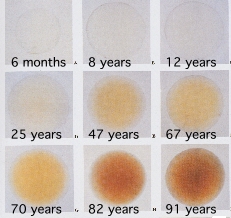Yellowing with age also occurs in the lens of the eye:

- lensesAge.jpg (41.81 KiB) Viewed 7252 times
Image:
http://people.brandeis.edu/~sekuler/Sen ... etOld.html
Proteins (polymers of amino acids) in the lens react with reducing sugars, such as fructose, via nonenzymatic glycosylation (glycation) to produce a condensation product that can rearrange and undergo further reactions to produce crosslinked proteins and light-absorbing structures, thus yielding a yellow or brown color. The same sort of reaction takes place in the browning of foods. The "browning" or "yellowing" of proteins in the human body is accelerated by diabetes and is thought to contribute to diseases of aging and/or diabetes, such as cataract, cardiovascular disease, and diabetic neuropathy.
I do not know how far this analogy holds between the yellowing/browning of plastics and proteins, but I doubt that aging or the complications of diabetes could be remedied by Retrobrite! Nevertheless, it could be that reactions similar to the Maillard reaction are taking place in certain synthetic polymers. If we could characterize and understand the mechanism(s) of these reactions, we might be more effective at preventing or reversing the yellowing of certain plastics. It is even conceivable that by understanding these reactions in plastics, we might indeed devise ways of reversing some of the effects of aging or diabetes on proteins in the human body, but using treatments less chemically aggressive than Retrobrite.
BTW, the yellowing of the lens has been documented to have an effect on the perception of color. Because yellow filters out blue light, artists tend to perceive less blue as they age, and this is reflected in their paintings. However, artists who have had their lenses removed for treatment of cataracts start painting with a renewed emphasis on the blue end of the spectrum.